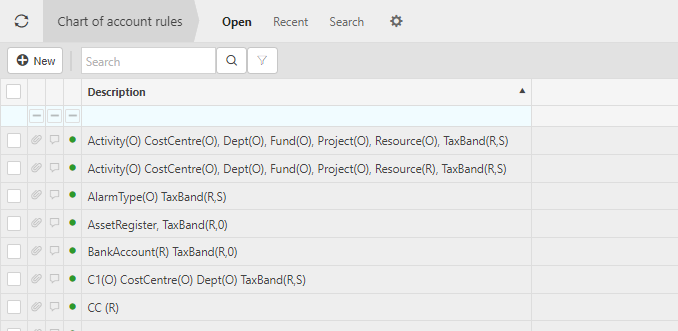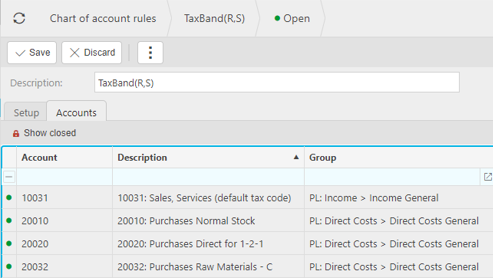Chart of Account Rules
Only users with access to the ‘Account admin’ User role will be able to view the Chart of account rules.
Each new Account created on the Chart of Accounts must be assigned a set of rules. iplicit has pre-defined rules which can be edited, copied or new rules created.
The rules are the Attributes that are relevant to the account when used on a transaction, for instance Tax codes, Departments, Cost Centres.
Account rules can be assigned to Product records, which will take priority over the rule set on the account.
For instance, there may be a single Chart of Accounts for Travel costs but depending on the Product some types of expense may/may not include Tax.
How to view Chart of Account Rules
View Chart of Account Rules
To enter the Chart of account rules menu, either select Chart of account rules in the Settings - GL section from the pulse menu -

Note
This is an example screen shot of the pulse menu.
Position of of the menu items within pulse will vary according to available options and dependant on personal screen resolution
or enter Chart of account rules in the Quick Launch Side Menu.

Once you have enter the appropriate menu for Chart of account rules, the screenshot below shows a sample grid of the rules, which includes some key information.

How to create Chart of Account Rules
Create a Chart of Account Rules
Select Chart of account rules from one of the options as shown above.
Select New.

Enter a description for the rule.
Tip
Make the Description a useful means of identification of the rules The rule below shows Cost Centre, Department & Project are all Optional, the Tax Band is Required & Defaults to Standard.

This is very useful for identification purposes at the time of selection.
Click on the Select button on the Setup tab.

- This displays the Select Attributes screen. Using the Arrow button
 , move any required Attributes from the available list to the selected list.
, move any required Attributes from the available list to the selected list.

Note
You must always include the Tax Band Attributes and it must be required Req. Only Attributes identified as Posting can be selected. This includes custom Attributes.
- This displays the Select Attributes screen. Using the Arrow button
Select Apply to save the selection(s).

Tip
The order of lines can be re-arranged using the arrows. Also, the end of the line displays the Delete icon if the attribute is no longer required.

Apply settings to each selected Attributes.
Each of the Attributes can have different settings applied for efficiency when used at transaction level.
Default value: optional field if populated the content will be pre-populated at transaction level.
Req (Required): if selected this means the field must be populated at transaction level.
Fixed: if selected this will block the default value from being altered at transaction level.
Setting hash, where relevant rather than using a default value the detail can be based on a setting on the system.
Note
In the example below the department field will be populated from the user department as per the user My Settings rather than from the default value on the rule.

Once complete, select the Create button.
Tip
Existing rules can be copied & amended to create new ones. Rules can be Locked if no longer required

Locked rules can also be deleted if they are not used by any Chart of Accounts.
The account tab of the record displays the Chart of account/s using this rule

How to see Chart of Account Rules in use
Show example of Chart of Account Rules in use
For Chart of Account Rule - CostCentre(R), Dept(R), Interco(O), Project(R), Resource(R) TaxBand(R,S)
This has the follow attributes set. Tax Band has a default value set as Standard.

The Accounts tab shows the Chart of accounts that use this Chart of account rule.

Now select one of the accounts using the Chart of accounts menu e.g. 30600: Stationery & Printing
The Rule option shows the Chart of accounts rule above has been selected.

Now when this Chart of accounts is selected when creating, for example, a Purchase invoice, the account 30600: Stationery & Printing can be selected. This will then have dropdown boxes showing for each attribute that was defined in the Chart of account rule

Tax band has automatically populated with Standard as that was set as a default setting in the Chart of account rule.
How to set Interco on Chart of Account Rules
Interco
Interco Chart of accounts must have "Interco" ticked on the account and the attribute must be included on the related Chart of Account rule.

Updated September 2024